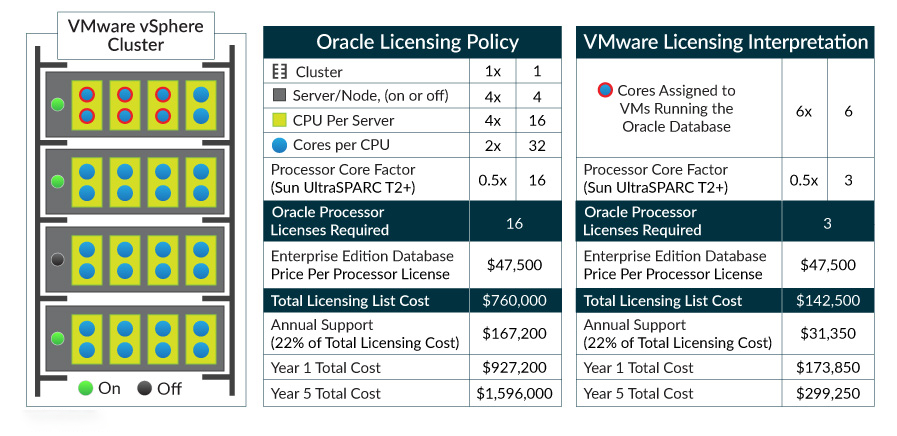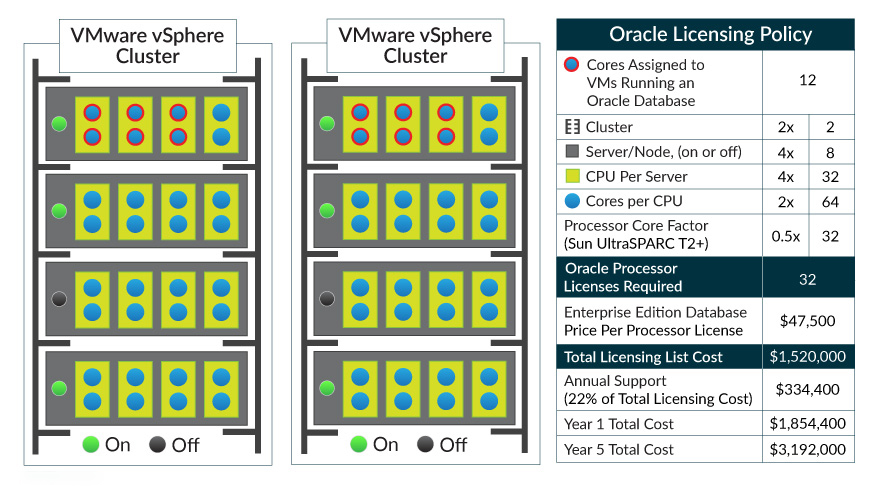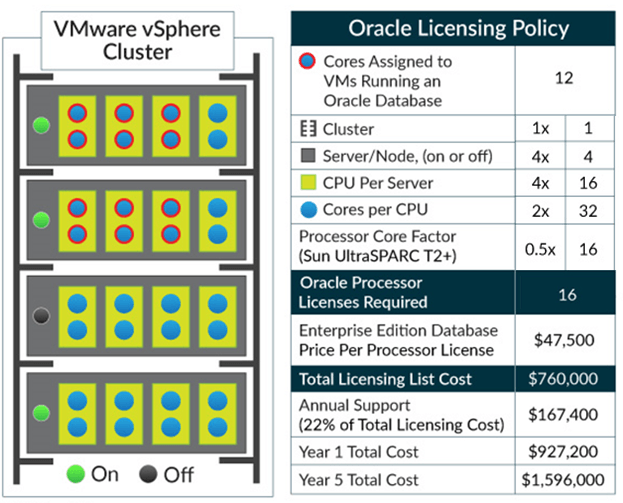- Erwann Couesbot
- Reading Time: 4 minutes

In a prior blog, we discussed the top 10 business scenarios impacting organizations’ risk exposure to an Oracle audit. These business events were described as either intentional by Oracle customers, such as deciding to cancel or reduce support agreements with Oracle, or unintentional, such as Oracle Licensing Management Service’s (LMS) average audit frequency of its customers every 3 to 5 years. While there is nothing a customer can do to change its software providers’ audit policies, organizations should do their best to avoid licensing audit triggers. This starts by identifying licensing practice red flags software providers are targeting. Running Oracle databases using VMware for server virtualization is one of these licensing compliance red flags for Oracle.
Unfortunately, Oracle will offer very limited guidance on how to properly apply database licensing metrics for non-Oracle virtualization software. Oracle customers must keep in mind the benefits coming with virtualization directly impact the revenue stream of Oracle since it requires less physical hardware and consequently reduces the Oracle license counts, licensing fees, and related support fees.
Oracle vs. VMware Licensing Stance
VMware provides a leading virtualization platform which allows organizations to reduce hardware related costs and improve operational efficiencies in their IT environment. However, Oracle customers deploying VMware may unintentionally put themselves at risk of non-compliance due to the licensing complexities associated with virtual machines. Understanding these complexities is critical to remain compliant, especially when organizations restructure their IT landscape through upgrades or migrations to a new physical server.
To understand the licensing and compliance implications of using VMware for virtualization, let’s use a scenario to demonstrate the difference between VMware’s licensing interpretation compared to Oracle’s licensing policies:
Scenario A: An Oracle customer is using VMware vSphere to manage virtual machines in a cluster of 4 Sun UltraSPARC T2+ servers, where an instance of Oracle Database Enterprise Edition is running on a virtual machine with 6 cores assigned. There is no movement of the Oracle database across virtual machines.

Please note in this scenario the turned off server counts in Oracle’s processor license equation. This is due to Oracle’s policy requiring the entire server farm in the cluster to be counted and licensed because a customer has the potential ability to run the Oracle database on all connected servers and cores. Whereas VMware’s licensing interpretation only takes into account the actual cores assigned to the virtual machine running the Oracle database.
So under Oracle’s licensing policies, with VMware, organizations will still obtain the benefits associated with virtualization, however, they will not realize any cost savings with respect to Oracle database licenses and related support. Some would argue that Oracle’s policies are unfair and do not reflect the actual core usage requirements associated with virtualization, and Oracle has been unwilling to modify its policies as this would result in a significant loss of revenue.
For references, the Oracle Processor Core Factor Table is accessible here and the current price of the Oracle Database Enterprise Edition can be found here. It is also recommended to review VMware’s own white paper on licensing Oracle using its virtualization software.
Ensure Compliance and Avoid Unnecessary Licensing Cost with an Optimal System’s Architecture
Based on Oracle licensing policy in VMware virtual environment, it is considered bad practice to have an Oracle database running on a single VMware virtual machine on a virtualized server or in the worst case scenario, a VMware cluster. To understand how such cluster architecture would impact the total processor licenses count based on Oracle licensing policy, let’s discuss another scenario:
Scenario B: Using the same virtual environment configuration in the VMware cluster as presented in scenario A, let us assume an Oracle customer runs two instances of an Oracle database Enterprise Edition on two single VMware virtual machines with 6 cores assigned each, each installed in one of two clusters. Accordingly, the core licensing count required based on Oracle licensing policy and related licensing cost for both clusters would be as follows:

In this cluster architecture, because the cores assigned to the virtual machines running an Oracle database instance may “contact” any other processors on any of the servers in the cluster, the organization would have to fully license both clusters.
One cheaper solution to avoid licensing all unassigned cores to the virtual machines in a cluster running an Oracle database is to segregate the Oracle database on a physical system outside of the cluster. While this is a cheaper option compared to the partially used clusters as described above, this could lead to unnecessary hardware cost for an organization running multiple Oracle databases.
Finally, for organizations with a large portfolio of Oracle databases to run, the recommended system architecture is to assign all of the Oracle databases to a dedicated fully licensed physical server or cluster. This architecture allows Oracle customers to deploy an unlimited number of virtual machines running additional Oracle database instances and benefit from the highest hardware infrastructure utilization optimization.
Scenario C: Using the same virtual environment configuration in the VMware cluster as presented in scenario B, but this time, the Oracle customer consolidates both VMware virtual machines with 6 cores assigned each running an instance of an Oracle database Enterprise Edition in one fully licensed cluster.

This fully licensed cluster scenario requires half the number of Oracle processor licenses compared to scenario B because any of the cores can be assigned to an unlimited number of virtual machines. Not only does this systems architecture optimize an organization’s physical processors and licensing cost, but it also ensures compliance with Oracle’s licensing policies.
Follow me on Twitter @ErwannCouesbot, find my other UpperEdge blogs, and follow UpperEdge on Twitter and LinkedIn